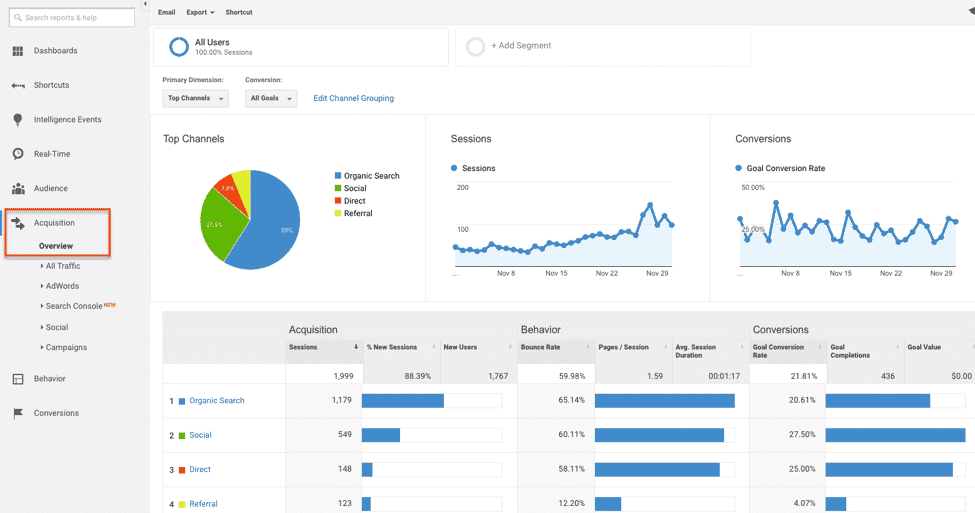We live in the information economy. Today, knowing your customer puts your miles ahead of any competitors who don’t understand who they’re selling to. No matter what you’re offering or what your website purposes to do, you have to know who your customers are so you can make better decisions about how to operate your business.
What does it mean to know your customers in the age of the internet? It’s all about data. The one with the most data is the one who can make the more informed decisions.
Conveniently for you and every other business or individual online, collecting and sharing data is also big business. Tools, programs, and apps of all types are aimed at tracking, measuring, and compiling useful reports about different types of customer data. Google Analytics is the biggest name in the game.
Since 2005, Analytics has been actively tracking visitors to your website and the subsequent data trails they leave behind them. They’re a big part of measuring data, but they’re not the only player in the game and they don’t necessarily give you everything you need.
What Does Google Analytics Measure?
Before we get into what Google Analytics can’t tell you, let’s take a quick look at some of the things Analytics can tell you. It’s a highly traffic-centric program that mostly focuses on how much traffic you’re getting, where that traffic comes from, and when they leave. Analytics can tell you all of these things and more:
· Site Traffic Levels
· Traffic Specifics (New visitors, unique visitors, etc…)
· Exit Pages
· Traffic Sources
· Conversion Rate
· Customer Behaviors
· Purchase Data
· Opt-ins/Clicks

Source: shivarweb.com
This sounds great, right? It’s a good place to start. There’s no doubt that being connected to Analytics is valuable. The data you get from that program alone can help you transform your website and your entire business into a better version of itself that services your site visitors and your customers more effectively.
Now, it’s time for the bad news.
What Google Analytics Can’t Measure
Google Analytics isn’t the one stop shop solution that it’s sometimes built up to be. It does a lot, but not everything. Some of this comes from the difficulty in measuring certain things while other holes in the data come from Google purposely hiding information from you.
At the end of the day, Google is a business. They don’t necessarily want you to know how everything works together and exactly how things are happening with traffic on your site. Some of that information would likely compromise their search algorithms, leading to a surge of SEO hacks and tricks to game the system.
Google Analytics does a lot for you. But, certain metrics are completely out of reach for the program. These are six of the most significant statistics where Google Analytics can’t help you get the best numbers.
User Experience
Analytics is great for finding out how people get to you and some of what they’re doing on your site, but it can’t tell you how they feel while they’re interacting with you. What is the customer experience for people who visit your site?
· Are people satisfied when they leave?
· Do they find your site easy to navigate and use?
· Are they happy with what you’re offering?
· How quickly are they able to accomplish their goals with your site?
User experience is a difficult statistic to measure at any rate. Google Analytics is completely unable to give you any insight into what people are feeling about their experience with your website.
According to research by companies like GetVoIP, customer experience is a very important part of success in digital marketing today. A good customer experience leads to happier, more loyal customers while a bad experience causes a higher customer churn rate.
Visitor Intent
You can tell where people come from, but you can’t tell why they came to your site. There are little clues such as the keywords used to bring them (if you can even get that data… more on this later), but there’s no measure to tell you about the intent of your visitors.
Intent is a big deal. It can help you shape your landing pages and get your content strategy settled into something more useful. If you don’t know what people want from your website, how can you give it to them?
Visitors can have many different intentions. They could be looking to buy, learn, explore, or entertain themselves. Depending on their intentions, you need to present the right landing pages, content, or CTAs to attract their attention and get them to stick. Someone coming to buy doesn’t want to read a long informational brief, but someone coming to learn will appreciate it.
You can’t be expected to change your whole website and strategy to accommodate the intentions of your visitors, but you can work to shift your marketing to attract more people with the right intentions to match your content, as long as you know about visitor intent.
User Interactions
Google Analytics does give you some information about what people are doing once they’re on your website, but it’s not a complete picture. You want to know exactly what people are doing, how they’re interacting with your pages, where they linger, and where they jump off.
If you know exactly how people dare using your site and how they’re interacting with you, it’s a lot easier to tailor your site to make it even better. This also ties into user experience, because the way people interact with you can give you clues about how their experience was.
You want to know what people do during their session.
· What pages do they visit?
· How do they get there?
· Are they reading the pages fully, or abandoning them halfway through?
· Do people start shopping and abandon their carts? Why? When?
· Are people consistently jumping off from the same point?
· Are people consistently clicking the same options?
How people interact with your website matters. Any information you can gain about those interactions make it easier to improve your site over time and make changes that actually matter for the functions your customers want.
Accurate Attribution
Attribution is the credit given to a specific source for a desired outcome. Google Analytics does try to give attribution, but its accuracy is questionable. You can get attribution measures and see where people came from, where conversions originated, and other stats, but those numbers could be way off.
The problem with Google Analytics is that it doesn’t always have a good grasp of who your visitors are and how often they’ve visited your site, or where they came from. If a user lands on your site and bounces, then returns days later after their browser cookies have been cleared and turns into a conversion, Analytics will attribute that conversion to direct traffic. Even though this user has visited your site before, clearing their cookies means that Analytics lost track of them.
You can get around this a little bit by implementing unique user IDs for each visitor, but Google notoriously refuses to allow any personal information to be tracked with their Analytics programs. It’s a good policy for the company, but it’s not great for you if you want to know where your conversions are actually coming from.
This also plays out with social media or off-site interactions. Users who are interacting with you over social media might never visit your site until they one day decide to stop by and make a purchase or otherwise interact with your content. Recording them as a first-time visitor isn’t exactly accurate because they already have a longstanding relationship with your brand. They might even have converted with you before, but not on your website directly.
The other attribution problem that comes from data privacy is that Google Analytics cannot tell you when a conversion, visit, or any other positive interaction comes from a business or and individual. For B2B businesses, this information could be a game changer, but there’s no way to find out through Google Analytics who your visitors are specifically enough to follow up on the leads.
Keyword Data
The one thing you would imagine Google Analytics to be amazing at would be integration with your SEO keyword strategy. However, Google has a mixed relationship with the entire SEO community. They understand and acknowledge it, but they don’t show their cards and they don’t make it easy for people to learn much about how effective their keyword strategies are, or why they’re working.
To this end, Google Analytics will integrate with your Adwords or keyword apps, but you shouldn’t expect to get all the data you want. Often, the most valuable data simply won’t be available on Analytics. It’s not that Google doesn’t know how well your keywords are doing to bring conversions, how you’re doing in search, or what effect your SEO work is having on your traffic, but they’re not just going to tell you.
Call Data
Google Analytics does not offer any integration to offline communications or even most non-traditional online communications. If visitors are lingering on your site because they saw your phone number and made a quick call to ask a question, Analytics might just count them as a bounce rather than a successful visit or a conversion, since they have no way of tracking call data.
GetVoIP (Voice over IP) calls can help with this in some ways, because they require a click in order to start the call. This click can be recorded and tracked by Analytics as an interaction. However, live chat tools and other non-traditional communications might be more difficult for Analytics to track and measure.
Calls might be the missing piece that make sense of strange user interactions. Or, in cases where calls are the literal CTA, not tracking calls makes it difficult to see how well your website is doing to drive people to action. You have to find a way to connect your traffic to your calls without the direct help of Analytics.
Filling the Gaps
Google Analytics is a fantastic source for traffic data on your website. It lays the groundwork that helps you understand how many people are seeing your site, how they’re interacting with it, how sticky your site is, and so much more. However, the shortcomings of Analytics sometimes leave big gaps in your data that you need to fill.
Look for alternative tools to track what Analytics won’t. Shane Barker recommended many other tools that can help you gain insights into these 6 measures and other areas where Analytics falls short. By using these third-party tools in combination with Analytics, you can finally start to get a clear picture of how all the pieces fit together, so you can then make better decisions with all the data.
If you’re not already connected to Google Analytics, get set up with it right away. But, don’t expect Analytics to provide you with every bit of information you need. There’s more to know, and you need to see where the limitations are so you can figure out how to get that data somewhere else.
Auhtor:
Georgi Todorov is a digital marketer, specializing in Outreach strategies, International SEO and Influencer Marketing. He recently started his own blog about digital marketing called DigitalNovas and joined GetVoIP to provide his marketing expertise.
